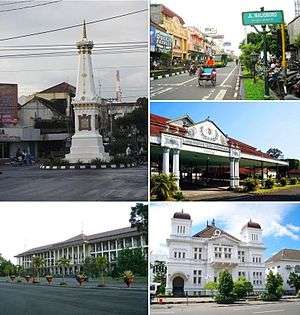Yogyakarta
| Yogyakarta Jogjakarta | ||
|---|---|---|
| City | ||
| Other transcription(s) | ||
| • Hanacaraka | ꦔꦪꦺꦴꦒꦾꦏꦂꦠ | |
|
From top left, clockwise: Tugu Monument, Jalan Malioboro, Kraton Yogyakarta, Bank Indonesia Yogyakarta, Gadjah Mada University | ||
| ||
| Nickname(s): Kota Pelajar (City of Students), Kota Budaya (Cultural City), Kota Gudeg (Gudeg City) | ||
| Motto: Memayu Hayuning Bawono | ||
 Location of Yogyakarta in Yogyakarta Special Region | ||
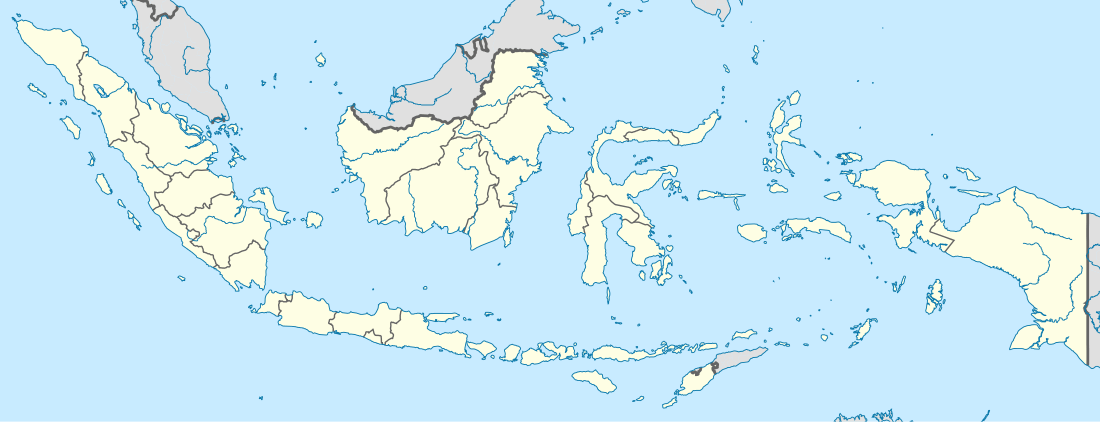 Yogyakarta Location of Yogyakarta in Indonesia | ||
| Coordinates: 7°48′5″S 110°21′52″E / 7.80139°S 110.36444°ECoordinates: 7°48′5″S 110°21′52″E / 7.80139°S 110.36444°E | ||
| Country | Indonesia | |
| Province | Yogyakarta Special Region | |
| Government | ||
| • Mayor | Haryadi Suyuti | |
| Area | ||
| • City | 46 km2 (18 sq mi) | |
| • Metro | 2,159.1 km2 (833.6 sq mi) | |
| Elevation | 113 m (371 ft) | |
| Population (2010 census) | ||
| • City | 388,627 | |
| • Density | 8,400/km2 (22,000/sq mi) | |
| • Metro | 4,010,436 | |
| • Metro density | 1,900/km2 (4,800/sq mi) | |
| Time zone | WIB (UTC+7) | |
| Area code(s) | +62 274 | |
| Vehicle registration | AB | |
| Website | www.jogjakota.go.id | |
Yogyakarta (/ˌjɒɡjəˈkɑːrtə/ or /ˌjoʊɡjəˈkɑːrtə/;[1] also Jogja or Jogjakarta, is a city and the capital of Yogyakarta Special Region in Java, Indonesia. It is renowned as a center of education (Kota Pelajar), classical Javanese fine art and culture such as batik, ballet, drama, music, poetry, and puppet shows. Yogyakarta was the Indonesian capital during the Indonesian National Revolution from 1945 to 1949, with Gedung Agung as the president's office. One of the districts in Yogyakarta, Kotagede, was the capital of the Mataram Sultanate between 1575 and 1640. The city is named after the Indian city of Ayodhya from the Ramayana epic. Yogya means "suitable, fit, proper", and karta, "prosperous, flourishing" (i.e., "a city that is fit to prosper").[2] Its population was 388,627 inhabitants at the 2010 census and its built-up (or metro) area was home to, 4,010,436 inhabitants spread on two cities (Yogyakarta and Magelang) and 65 districts spread on Sleman, Klaten, Bantul, Kulon Progo and Magelang regencies. While urbanization sprawls, Yogyakarta-Magelang and Surakarta are being agglomerated in a few years. The Dutch name of the city is Jogjakarta.
History
Mataram Kingdom (8th – 10th century CE)
According to Canggal inscription dated 732, the area traditionally known as "Mataram" became the capital of the Medang Kingdom, identified as Mdang i Bhumi Mataram established by King Sanjaya. Mataram became the center of a refined and sophisticated Javanese Hindu-Buddhist culture, for about three centuries its heartland in Kewu Plain (southern slope of Mount Merapi) around Prambanan witnessed the construction of numerous candi including Borobudur and Prambanan.
Around the year 929, the centre of the kingdom was shifted to East Java by Mpu Sindok, who established the Isyana Dynasty. The exact cause of the move is still uncertain; however, a severe eruption of Mount Merapi volcano or a power struggle probably caused the move. Historians suggest that, some time during the reign of King Wawa of Mataram (924–929), Merapi volcano erupted and devastated the kingdom's capital in Mataram.
Majapahit Empire (1293–1527)
During the Majapahit era, the area surrounding modern Yogyakarta was identified again as "Mataram" and recognized as one of the twelve Majapahit provinces in Java ruled by a Duke titled 'Bhre Mataram'. During the reign of Hayam Wuruk (1350 to 1389), the title of Bhre Mataram was held by king's nephew and son in-law Wikramawardhana.
Mataram Sultanate (1575–1620)
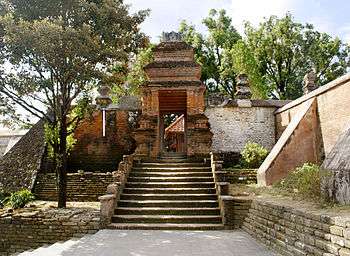
Kotagede (now a district of Yogyakarta) was established as the capital of the Mataram Sultanate. During the reign of Sultan Agung Hanyokrokusumo (1613-1645), the Sultanate Mataram reached its zenith as the greatest kingdom in Java, and expanded its influence to Central Java, East Java and half of West Java. After two changes of capital, (Palace of Pleret and Place of Kerta, both located in Bantul Regency), the capital of Mataram Sultanate moved to Kartasura.
Aftermath of the Gianti Treaty (1745–1945)

.jpg)
During the reign of Pakubuwono II, a civil war broke out in Mataram Sultanate. The civil war was fought between Prince Mangkubumi and his elder brother, Sunan Pakubuwono II. It started when Sunan Pakubuwono II agreed to cooperate with the VOC, ceded some Mataram territory to the Dutch, and submitted to the foreign power. His younger brother, Prince Mangkubumi stood against the agreement due to concerns that his people would become slaves under Dutch rule. Prince Mangkubumi defeated the Pakubuwono forces and declared sovereignty in the Kingdom of Yogjakarta occupying the southern parts of the former Mataram Sultanate.
The Yogyakarta Sultanate was established as a result of the Treaty of Giyanti (Perjanjian Gianti) by Prince Mangkubumi, who later ascended the throne as Sultan Hamengkubuwono I. Officially, the creation of Yogyakarta Sultanate is dated at 7 October 1756 as a result of civil war among the princes of The Mataram Sultanate. This civil war marked the end of the Mataram Sultanate and resulted in the birth of the Yogyakarta Sultanate and the Surakarta Sunanate.
During the British occupation of Java, rumors of plans by the Javanese court to stage a rebellion caused uneasiness among the colonial authorities. On 20 June 1812, Stamford Raffles led a 1,200-strong British force to attack the royal city. The Javanese were surprised by the attack and were easily subdued. In one day the city of Yogyakarta fell, with the city destroyed and its palace looted. The event completely stripped the sultanate of its remaining power and influence.[3] The sack also left the court humiliated and fueled a rebellion which would be known as Java War.
Republic of Indonesia era (1945–present)
In 1942 the Japanese Empire invaded Dutch East Indies and ruled Java until they were defeated in 1945. Sukarno proclaimed the independence of the Indonesian Republic on August 1945. Sultan Hamengkubuwono IX promptly sent a letter to Sukarno, expressing his support for the newly born nation of Indonesia and acknowledging the Yogyakarta Sultanate as part of the Indonesian Republic. The Sunanate of Surakarta did the same, and both of the Javanese kingdoms were awarded special status as "Special Regions" within the Indonesian Republic. However, because of a leftist anti-royalist uprising in Surakarta, the Sunanate of Surakarta lost its special administrative status in 1946 and was absorbed into Central Java Province.
Yogyakarta's support was essential in the Indonesian struggle for independence during the Indonesian National Revolution (1945-1949). The city of Yogyakarta became the capital of the Indonesian Republic from 1946 to 1948, after the fall of Jakarta to the Dutch. Later the Dutch also invaded Yogyakarta, causing the Republic's capital to be transferred once again, to Bukittinggi in West Sumatra on 19 December 1948. Because of its significant contribution to the survival of the Indonesian Republic, Yogyakarta was given the status of Special Administrative Region, making Yogyakarta the only region headed by a monarchy in Indonesia.
Geography
The area of the city of Yogyakarta is 32.5 square kilometres (12.5 square miles). While the city spreads in all directions from the kraton (the Sultan's palace), the core of the modern city is to the north, centered around Dutch colonial-era buildings and the commercial district. Jalan Malioboro, with rows of pavement vendors and nearby market and malls, is the primary shopping street for tourists in the city, while Jalan Solo, further north, is a shopping district more frequented by locals. At the southern end of Malioboro, on the east side is the large local market of Beringharjo, not far from Fort Vredeburg, a restored Dutch fort.
At Yogyakarta's centre is the Kraton, or Sultan's palace. Surrounding the kraton is a densely populated residential neighbourhood that occupies land that was formerly the Sultan's sole domain. Evidence of this former use remains in the form of old walls and the ruined Taman Sari, built in 1758 as a pleasure garden. No longer used by the sultan, the garden has been largely abandoned. For a time, it was used for housing by palace employees and descendants. Reconstruction efforts began in 2004, and an effort to renew the neighbourhood around the kraton has begun. The site is a developing tourist attraction.
Nearby to the city of Yogyakarta is Mount Merapi. The northern outskirts of the city run up to the southern slopes of the mountain in Sleman Regency (Indonesian language–Kabupaten). Gunung Merapi (literally "mountain of fire" in Indonesian/Javanese), is an active stratovolcano located on the border between Central Java and Yogyakarta, Indonesia. It is the most active volcano in Indonesia and has erupted regularly since 1548. The South Of Merapi is Kaliurang Kaliurang Park. The volcano last erupted in November 2010.
Climate
Climate in Yogyakarta features tropical wet and dry climate (Aw) as the precipitation in the driest month, August is below 60 mm. The wettest month in Yogyakarta is January with precipitation total 392 mm. The climate is influenced by the monsoon. The annual temperature is roughly about 26 to 27 Celsius. The hottest month is April with average temperature 27.1 Celsius.
| Climate data for Yogyakarta, Indonesia | |||||||||||||
|---|---|---|---|---|---|---|---|---|---|---|---|---|---|
| Month | Jan | Feb | Mar | Apr | May | Jun | Jul | Aug | Sep | Oct | Nov | Dec | Year |
| Record high °C (°F) | 31 (88) |
32 (90) |
32 (90) |
33 (91) |
32 (90) |
32 (90) |
32 (90) |
32 (90) |
34 (93) |
35 (95) |
35 (95) |
32 (90) |
35 (95) |
| Average high °C (°F) | 29.8 (85.6) |
30.2 (86.4) |
30.4 (86.7) |
31.3 (88.3) |
31.1 (88) |
31.0 (87.8) |
30.3 (86.5) |
30.7 (87.3) |
31.1 (88) |
31.4 (88.5) |
30.7 (87.3) |
30.1 (86.2) |
30.68 (87.22) |
| Daily mean °C (°F) | 26.3 (79.3) |
26.5 (79.7) |
26.6 (79.9) |
27.1 (80.8) |
26.9 (80.4) |
26.2 (79.2) |
25.4 (77.7) |
25.6 (78.1) |
26.4 (79.5) |
27.0 (80.6) |
26.8 (80.2) |
26.4 (79.5) |
26.43 (79.58) |
| Average low °C (°F) | 22.9 (73.2) |
22.8 (73) |
22.9 (73.2) |
23.0 (73.4) |
22.7 (72.9) |
21.5 (70.7) |
20.6 (69.1) |
20.6 (69.1) |
21.7 (71.1) |
22.7 (72.9) |
23.0 (73.4) |
22.8 (73) |
22.27 (72.08) |
| Record low °C (°F) | 20 (68) |
20 (68) |
18 (64) |
20 (68) |
18 (64) |
16 (61) |
17 (63) |
16 (61) |
17 (63) |
18 (64) |
20 (68) |
20 (68) |
16 (61) |
| Average precipitation mm (inches) | 392 (15.43) |
299 (11.77) |
363 (14.29) |
149 (5.87) |
141 (5.55) |
68 (2.68) |
29 (1.14) |
16 (0.63) |
49 (1.93) |
136 (5.35) |
237 (9.33) |
278 (10.94) |
2,157 (84.91) |
| Average relative humidity (%) | 82 | 82 | 81 | 78 | 77 | 74 | 74 | 71 | 69 | 73 | 77 | 82 | 76.7 |
| Source #1: Climate-Data.org (temp and precip)[4] | |||||||||||||
| Source #2: Weatherbase (temp records & humidity)[5] | |||||||||||||
Administration
The city of Yogyakarta is an administrative part of the Yogyakarta Special Region which has the status of a province in Indonesia. The regencies of Bantul and Sleman have population densities far higher than the surrounding countryside (over 1,500 per square kilometer) and are effectively dormitory communities of the greater area of Yogyakarta. Within the greater Yogyakarta area lies the city of Yogyakarta called Kota Yogyakarta. Yogyakarta Special Region having 4 regency and 1 city: 1. Kulon Progo the capital is Wates 2. Sleman the capital is Sleman 3. Bantul the capital is Piyungan 4. Gunung Kidul the capital is Wonosari and 5. Yogyakarta City.
Yogyakarta is divided into 14 districts (kecamatan), listed below with their populations as of the 2010 Census:[6]
|
|
|
|
Economy
The Gross Domestic Product of Yogyakarta in 2014 reached Rp 24.69 trillions with the economic growth rate is 5.30 percent. Meanwhile, the average economic growth during the period 2010-2014 reached 5.51 percent per year. The GDP per capita is Rp 60.57 million. Yogyakarta economy heavily relies on tertiary sectors, such as wholesale and retail trade; transportation and warehousing; tourism; information and communication sector; insurance and financial services; real estate; corporate services; government administration; education services; health services which all of them contribute 77.19 per cent of total GDP.
Demographics
A large majority of the population are native Javanese. However, as a city with large numbers of schools and universities and relatively low cost of living compared to other Indonesian cities, Yogyakarta has attracted large numbers of students from all over Indonesia. As a result, there are many other Indonesian ethnic groups living in Yogyakarta, especially from eastern parts of Indonesia.
Yogyakarta attracts large numbers of foreign visitors. However, there are also significant numbers of foreign people residing in the city. Most of them are foreign students that usually stay to learn Indonesian or Javanese culture.
Tourism
Because of its proximity to the Borobudur and Prambanan temples, and because of the Javanese court Kraton culture of Kraton Yogyakarta, Yogyakarta has become an important tourist destination in Indonesia. Most tourists come to Yogyakarta as an accommodation base to visit Borobudur and Prambanan. At tourist sites, you may meet high school students who look forward to have a conversation in English with you to polish their language skills.
Geoheritage sites
Nine rock sites in the Yogyakarta area have been declared as geoheritage sites.[8]
|
|
|
Other sites
- Kalisuci Cave in Semanu, Gunung Kidul
- Pindul Cave in Gunung Kidul
- Timang Beach in Gunung Kidul
- Krakal Beach in Gunung Kidul
Culture
_from_central_Java%2C_a_scene_from_'Irawan's_Wedding'.jpg)


Some of the famous cultural aspects of Yogyakarta are:
- Batik fabric production area. The most famous batik marketplace is Beringharjo market.
- Silverwork, fine filigree jewellery, the production center is in Kotagede
- Traditional Javanese dance performance, especially Ramayana Wayang wong dance performed in Prambanan and Purowisata. Other Javanese court dances are also performed in the Kraton.
- Wayang kulit, a traditional Javanese leather puppetry used for shadow plays.
- Contemporary puppetry and theatre, for example the Papermoon Puppet Theatre
- Gamelan music, including the local Gamelan Yogyakarta which was developed in the courts.
- Annual traditional Javanese festivals such as Sekaten or Gerebeg Mulud.
- Visual artists including the Taring Padi community in Bantul.
Cuisine
- Gudeg Yogya: a traditional food from Yogyakarta[9] and Central Java which is made from young unripe jack fruit boiled for several hours with palm sugar, and coconut milk. This is usually accompanied by opor ayam (chicken in coconut milk), hard boiled egg stew, and krechek a spicy beef inner skin and tofu stew. This dish has a unique sweet and savoury taste. The Yogyakarta gudeg is dryer and has a reddish coloring because of the addition of Java teak leaf.
- Ayam goreng Kalasan: chicken, stewed in spices consisting of coriander, garlic, candlenut, and coconut water, then deep-fried until crispy. Served with sambal and raw vegetables.
- Sego kucing: rice with small side dishes.
- Mung bean cake: a sweet pastry filled with sugared mung bean paste. Derived from Chinese pastry. The famous bakpia producing area is Pathok near Jalan Malioboro, where bakpia pathok is sold.
- Ronde (wedhang ronde): a hot Javanese dessert containing glutinous rice balls stuffed with peanut paste, floating in a hot and sweet ginger and lemongrass tea.
- Angsle (wedhang angsle): a hot soupy dessert of sago pearls, pre-cooked glutinous rice and mung beans, putu mayang (brightly colored, noodle-shaped flour cakes), fried peanuts all covered in hot, sweet coconut milk.
- Kipo: the name derived from Javanese word iki opo? (what is this?), a small sweet snack from Kotagede made of glutinous rice flour and coconut milk dough filled with grated coconut and palm sugar.
- Wedhang Uwuh (wedhang uwuh) : a hot Javanese drink of clove leaves.
Museums
Yogyakarta has several historical tourist attractions as the Candi Prambanan temple, museums in the royal court, and museums in colonial buildings such as the Fort Vredeburg Museum, a former Dutch fort. Due to the importance of Yogyakarta during the war of independence from the Dutch, there are numerous memorials and museums such as the Monument to the Recapture of Yogyakarta.
To the east of the town centre is the large Air Force Museum (Museum Pusat Dirgantara Mandala), with 36 aircraft in the building and six aircraft displayed outdoors. As Indonesia was for a period in the Soviet sphere of influence, this museum contains a number of vintage Russian aircraft not widely available for inspection in the NATO sphere of influence. The collection includes examples of the Mikoyan-Gurevich MiG-15 trainer, Mikoyan-Gurevich MiG-17, Mikoyan-Gurevich MiG-19, Mikoyan-Gurevich MiG-21 and Tupolev Tu-16, together with an assortment of Japanese, American and British aircraft.[10] Other museums include the Jogja National Museum.
Education
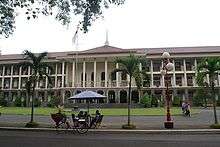
Yogyakarta is the home of Gadjah Mada University, one of Indonesia's most prominent universities. Other public universities in Yogyakarta include the Yogyakarta State University, Sunan Kalijaga Islamic University, and the Indonesian Institute of the Arts. The city also houses several well-known private universities such as Muhammadiyah University of Yogyakarta, Ahmad Dahlan University, Institut Sains dan Teknologi AKPRIND Yogyakarta, Islamic University of Indonesia, Atma Jaya University, Duta Wacana Christian University and Sanata Dharma University.
Transportation
Airport
Yogyakarta is served by Adisucipto International Airport which connects the city with other major cities in Indonesia, such as Jakarta, Surabaya, Denpasar, Makassar, Balikpapan, Banjarmasin, Pekanbaru, Palembang and Pontianak. It also connects the city with Singapore (operated by SilkAir and Indonesia AirAsia) and Kuala Lumpur (operated by AirAsia).
Rail
The city is located on one of the two major railway lines across Java between Jakarta / Bandung and Surabaya. It has two passenger railway stations, Tugu railway station which serves business and executive class trains, and Lempuyangan Station which serves economy class trains. Both stations are located in the heart of the city. One commuter train in Yogyakarta is the Prambanan Ekspress, also known as Prameks, which runs from Lempuyangan Station to Solo Balapan Station in Surakarta (Solo) (East of Yogyakarta), Kutoharjo Station in Kutoharjo (West of Yogyakarta). Other commuter trains run from Madiun Jaya (Madiun-Lempuyangan), and Joglosemar (Semarang-Lempuyangan).
Roads
The city has an extensive system of public city buses, and is a major departure point for inter-city buses to other cities in Java and Bali, as well as taxis, andongs, and becaks. Motorbikes are by far the most commonly used personal transportation, but an increasing number of residents own automobiles.[11] Yogyakarta also has a highway known as the Ringroad and overpasses including Janti Overpass, Lempuyangan Overpass, and a recently built overpass in the northern part of the Ringroad.
Buses

Since early 2008, the city has operated a bus rapid transit system called Trans Jogja, also known as "TJ" (Indonesian), an abbreviation from "T" for 'Trans', and "J" for 'Jogja'. This system is modeled after the TransJakarta system in the capital, but unlike Trans Jakarta, there is no particular lane for Trans Jogja buses; they run on main streets. Currently there are six Trans Jogja lines, with routes throughout the main streets of Yogyakarta, some of which are overlapping. The lines extend from Jombor bus station in the north as far as Giwangan main bus terminal in the south and Prambanan bus shelter in the east via Adisucipto International Airport.
Future transportation
In a 2008 forum discussion on long-term transportation plans in Yogyakarta held at Universitas Gadjah Mada, the head of the Yogyakarta region transportation master plan team, Prof Ahmad Munawar, said that in 2016 modern transport modes including monorail, aerobus, and tram will begin operating in the city and the region.[12]
Health facilities
Notable hospitals in Yogyakarta include :
- Dr. Sardjito Hospital (state-owned, the largest hospital in Yogyakarta)
- Bethesda Hospital
- Panti Rapih Hospital
- Muhammadiyah Hospital
Twin towns – Sister cities
 Gangbuk-gu, South Korea
Gangbuk-gu, South Korea Baalbek, Lebanon
Baalbek, Lebanon Huế, Vietnam
Huế, Vietnam Hefei, China
Hefei, China Kyoto, Japan[13]
Kyoto, Japan[13]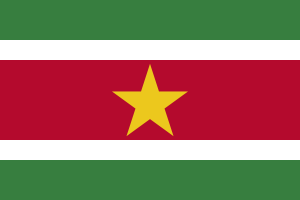 Commewijne, Suriname[14]
Commewijne, Suriname[14] Ipoh, Perak, Malaysia
Ipoh, Perak, Malaysia
See also
Notes
- ↑ "Yogyakarta | Define Yogyakarta at Dictionary.com". Dictionary.reference.com. Retrieved 5 June 2011.
- ↑ E.M. Pospelov, Geograficheskie nazvaniya mira (Moscow: Russkie slovari, 1998), p. 138.
- ↑ When Raffles ran Java, Tim Hanningan, historytoday.com
- ↑ "Climate: Yogyakarta". Climate-Data.org. Retrieved 19 May 2016.
- ↑ "YOGYAKARTA, INDONESIA". Weatherbase. Retrieved 19 May 2016.
- ↑ Biro Pusat Statistik, Jakarta, 2011.
- ↑ "Candi Borobudur dicatatkan di Guinness World Records". Antara News. Retrieved 10 July 2014.
- ↑ 'Nine unique geo-heritage sites declared', The Jakarta Post, 3 November 2014.
- ↑ Tempat Makan Favorit di 6 Kota. AgroMedia. 2008. p. 136. ISBN 9789790061668.
- ↑ "Muspusdirla, Koleksi Pesawatnya Luar Biasa". 19 April 2012.
- ↑ "Archived copy". Archived from the original on 14 February 2015. Retrieved 14 February 2015.
- ↑ "Tahun 2016, di DIY akan Beroperasi Monorail, Aerobus, dan Trem Listrik" (Indonesian)
- ↑ "Peringatan 25 Tahun Sister City Kyoto-Yogya, Kedua Kota Mendapat Manfaat" (in Indonesian). Koran Tempo. 6 October 2010. Retrieved 20 May 2014.
- ↑ "Kerjasama Sister City, Eratkan RI-Suriname" (in Indonesian). Ministry of Foreign Affairs of Republic of Indonesia. 7 April 2011. Retrieved 20 May 2014.
External links
| Wikimedia Commons has media related to Yogyakarta. |
- Official website
 Yogyakarta travel guide from Wikivoyage
Yogyakarta travel guide from Wikivoyage
